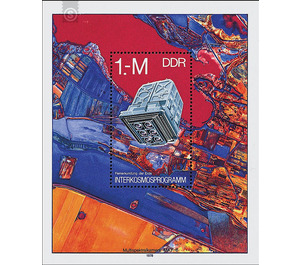Intercosmos program - Germany / German Democratic Republic 1978
Theme: Astronomy & Space
| Country | Germany / German Democratic Republic |
| Issue Date | 1978 |
| Item Type | Block |
| Chronological Issue Number | 3152 |
| Chronological Chapter | GER-DDR |
| SID | 689642 |
| In 21 Wishlists | |
Intercosmology Program The Ministry of Posts and Telecommunications of the German Democratic Republic publishes three multicolored special postage stamps and a multicolored special postage stamp block for the implementation of the Intercosmology Program. Intercosmic Program In 1965, the USSR proposed to the governments of Bulgaria, Hungary, Cuba, Poland, the Mongolian People's Republic, Romania, Czechoslovakia and the GDR the unification of the scientific and technological potential of the CMEA countries in the field of cosmic sciences. She declared from the outset their willingness to provide free means of transport (rockets, satellites) and the launch and ground technology for cosmic experiments. In April 1967, the joint "Program for Exploring and Utilizing the Cosmic Space for Peaceful Purposes", which in 1970 was given the name "lnterkosmos", was adopted. Four main directions of joint research have been agreed: Cosmic Physics, Cosmic Meteorology, Cosmic Communications and Cosmic Biology and Medicine. With the orientation towards a broader application of cosmos research for the economy in 1975, the remote sensing of the earth was determined by aerocosmic means as the fifth main direction. The GDR contributions focus primarily on the areas of cosmic physics and cosmic meteorology and increasingly on the recent mainstream. Focal points are the development and construction of apparatus and equipment systems for orbital missiles and research rockets for the measurement of physical parameters in near-Earth space or for remote sounding of the earth's surface and for data transmission to Earth. So far, 17 lnterkosmos satellites have been launched in the lnterkosmos community, 10 of which also include equipment from the GDR, which is also equipped with the spacecraft "Soyuz-22", two weather satellites "Meteor", one "cosmos". Satellites, from four "vertical" geophysical rockets and 24 meteorological rockets "MR-12" and "M-100" respectively. So far 42 101 objects have been used on 42 objects. In addition, more than 150 devices have been developed and built for ground use and on-board testing. 1.00-Mark-Block: Multispectral Camera MKF - 6 Designed by specialists of the USSR and DDR and designed and manufactured in the VEB Carl Zeiss Jena multi-spectral MKF-6 on the spacecraft "Soyuz -22" from September 15 to 21, 1976 successfully used for the task of testing and perfecting methods of remote sensing of the earth using multi-spectral techniques and to develop applications for earth resource research. The six film cassettes are mounted on the camera block with six lenses for recording in six spectral ranges - four in the visible and two in the near infrared range. At an altitude of 250 to 260 km, more than 1,000 images of a terrain piece of 115 km x 165 km can be taken with one cassette filling. The undercrop of a section of the Süßensee near Halle / Saale was made with the MKF-6 from the aircraft laboratory AN-30 and obtained in the mixed color projector MSP-4 as a synthesized color image, which allows a better recognition of physical properties and conditions of terrestrial objects ,


